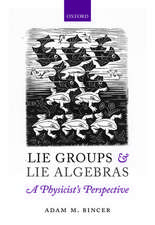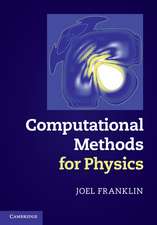Spectral Methods in Chemistry and Physics: Applications to Kinetic Theory and Quantum Mechanics: Scientific Computation
Autor Bernard Shizgalen Limba Engleză Hardback – 21 ian 2015
The eigenvalue spectra of the linear operators in the Boltzmann, Fokker-Planck and Schrödinger equations are studied with spectral and pseudospectral methods based on non-classical orthogonal polynomials.
The numerical methods referred to as the Discrete Ordinate Method, Differential Quadrature, the Quadrature Discretization Method, the Discrete Variable Representation, the Lagrange Mesh Method, and others are discussed and compared.
MATLAB codes are provided for most of the numerical results reported in the book - see Link under 'Additional Information' on the the right-hand column.
| Toate formatele și edițiile | Preț | Express |
|---|---|---|
| Paperback (1) | 572.40 lei 39-44 zile | |
| SPRINGER NETHERLANDS – 6 oct 2016 | 572.40 lei 39-44 zile | |
| Hardback (1) | 653.65 lei 6-8 săpt. | |
| SPRINGER NETHERLANDS – 21 ian 2015 | 653.65 lei 6-8 săpt. |
Din seria Scientific Computation
- 18%
 Preț: 1021.05 lei
Preț: 1021.05 lei - 18%
 Preț: 743.27 lei
Preț: 743.27 lei - 18%
 Preț: 889.75 lei
Preț: 889.75 lei - 18%
 Preț: 1108.51 lei
Preț: 1108.51 lei -
 Preț: 387.96 lei
Preț: 387.96 lei - 20%
 Preț: 902.00 lei
Preț: 902.00 lei -
 Preț: 400.85 lei
Preț: 400.85 lei -
 Preț: 386.61 lei
Preț: 386.61 lei - 15%
 Preț: 654.62 lei
Preț: 654.62 lei -
 Preț: 380.25 lei
Preț: 380.25 lei - 18%
 Preț: 1111.34 lei
Preț: 1111.34 lei -
 Preț: 452.62 lei
Preț: 452.62 lei -
 Preț: 389.31 lei
Preț: 389.31 lei - 18%
 Preț: 950.03 lei
Preț: 950.03 lei - 15%
 Preț: 649.22 lei
Preț: 649.22 lei - 15%
 Preț: 595.86 lei
Preț: 595.86 lei - 18%
 Preț: 942.63 lei
Preț: 942.63 lei - 15%
 Preț: 505.18 lei
Preț: 505.18 lei -
 Preț: 389.70 lei
Preț: 389.70 lei - 15%
 Preț: 653.00 lei
Preț: 653.00 lei - 18%
 Preț: 957.44 lei
Preț: 957.44 lei - 15%
 Preț: 653.98 lei
Preț: 653.98 lei - 15%
 Preț: 643.99 lei
Preț: 643.99 lei - 15%
 Preț: 649.39 lei
Preț: 649.39 lei -
 Preț: 388.13 lei
Preț: 388.13 lei - 18%
 Preț: 958.38 lei
Preț: 958.38 lei - 18%
 Preț: 1129.52 lei
Preț: 1129.52 lei - 18%
 Preț: 967.56 lei
Preț: 967.56 lei - 15%
 Preț: 700.75 lei
Preț: 700.75 lei -
 Preț: 401.03 lei
Preț: 401.03 lei - 15%
 Preț: 597.99 lei
Preț: 597.99 lei -
 Preț: 385.62 lei
Preț: 385.62 lei -
 Preț: 394.87 lei
Preț: 394.87 lei -
 Preț: 385.08 lei
Preț: 385.08 lei - 18%
 Preț: 1106.63 lei
Preț: 1106.63 lei - 15%
 Preț: 504.17 lei
Preț: 504.17 lei - 15%
 Preț: 596.36 lei
Preț: 596.36 lei - 15%
 Preț: 653.98 lei
Preț: 653.98 lei
Preț: 653.65 lei
Preț vechi: 769.00 lei
-15% Nou
125.08€ • 130.33$ • 103.56£
Carte tipărită la comandă
Livrare economică 03-17 aprilie
Specificații
ISBN-10: 9401794537
Pagini: 415
Ilustrații: XVII, 415 p. 102 illus., 2 illus. in color.
Dimensiuni: 155 x 235 x 23 mm
Greutate: 0.79 kg
Ediția:2015
Editura: SPRINGER NETHERLANDS
Colecția Springer
Seria Scientific Computation
Locul publicării:Dordrecht, Netherlands
Public țintă
ResearchCuprins
Preface.- Introduction to Spectral/Pseudospectral Methods.- Polynomial Basis functions and Quadratures.- Numerical Evaluation of Integrals and Derivatives.- Representation of Functions in Basis Sets.- Integral Equations in the Kinetic Theory of Gases and Related Topics.- Spectral and Pseudospectral Methods of Solution of the Fokker-Planck and Schrödinger Equations.- Index.
Notă biografică
Bernard Shizgal was born in 1942 in Montreal, Canada. He received a B.Sc. in Honours Chemistry and Physics from McGill University in 1964, and a Ph.D. in Chemical Physics from Columbia University in 1968 under the supervision of Martin Karplus. He was a postdoctoral fellow in Physics at Leiden University in the Netherlands with Peter Mazur, and in Chemistry at the University of British Columbia with Bob Snider before his appointment there as an Assistant Professor in 1970. His interests in kinetic theory naturally lead to research projects in space physics and the implementation of pseudospectral methods. On numerous occasions he was a Fellow of the Japanese Society for the Promotion of Science and a visiting Professor at the Japan Aerospace Exploration Agency, the National Institute of Information and Communications Technology, the Solar Terrestrial Environment Laboratory of Nagoya University and other institutes in Japan. His interests in mathematics and spectral methods were pursued as a visiting Professor in the Department of Mathematics, at the Université de Nice Sophia-Antipolis and at the Institut Nonlinèare de Nice, France. Professor Shizgal has approximately 140 publications in peer-reviewed journals. He is currently Professor Emeritus at the University of British Columbia and remains active with research projects in kinetic theory and quantum mechanics, with applications to atmospheric and space science, stochastic processes, rarefied gas dynamics and pseudospectral methods.
Textul de pe ultima copertă
This book is a pedagogical presentation of the application of spectral and pseudospectral methods to kinetic theory and quantum mechanics. There are additional applications to astrophysics, engineering, biology and many other fields. The main objective of this book is to provide the basic concepts to enable the use of spectral and pseudospectral methods to solve problems in diverse fields of interest and to a wide audience.
While spectral methods are generally based on Fourier Series or Chebychev polynomials, non-classical polynomials and associated quadratures are used for many of the applications presented in the book. Fourier series methods are summarized with a discussion of the resolution of the Gibbs phenomenon.
Classical and non-classical quadratures are used for the evaluation of integrals in reaction dynamics including nuclear fusion, radial integrals in density functional theory, in elastic scattering theory and other applications.
The subject matter includes the calculation of transport coefficients in gases and other gas dynamical problems based on spectral and pseudospectral solutions of the Boltzmann equation. Radiative transfer in astrophysics and atmospheric science, and applications to space physics are discussed. The relaxation of initial non-equilibrium distributions to equilibrium for several different systems is studied with the Boltzmann and Fokker-Planck equations.
The eigenvalue spectra of the linear operators in the Boltzmann, Fokker-Planck and Schrödinger equations are studied with spectral and pseudospectral methods based on non-classical orthogonal polynomials.
The numerical methods referred to as the Discrete Ordinate Method, Differential Quadrature, the Quadrature Discretization Method, the Discrete Variable Representation, the Lagrange Mesh Method, and others are discussed and compared.
MATLAB codes are provided for most of the numerical results reported in the book.
Caracteristici
Provides a unique demonstration of the overlap of the numerical treatment of problems in kinetic theory and quantum mechanics
Illustrates methods that emphasize the use of non-classical basis sets
Descriere
This book is a pedagogical presentation of the application of spectral and pseudospectral methods to kinetic theory and quantum mechanics. There are additional applications to astrophysics, engineering, biology and many other fields. The main objective of this book is to provide the basic concepts to enable the use of spectral and pseudospectral methods to solve problems in diverse fields of interest and to a wide audience. While spectral methods are generally based on Fourier Series or Chebychev polynomials, non-classical polynomials and associated quadratures are used for many of the applications presented in the book. Fourier series methods are summarized with a discussion of the resolution of the Gibbs phenomenon. Classical and non-classical quadratures are used for the evaluation of integrals in reaction dynamics including nuclear fusion, radial integrals in density functional theory, in elastic scattering theory and other applications. The subject matter includes the calculation of transport coefficients in gases and other gas dynamical problems based on spectral and pseudospectral solutions of the Boltzmann equation. Radiative transfer in astrophysics and atmospheric science, and applications to space physics are discussed. The relaxation of initial non-equilibrium distributions to equilibrium for several different systems is studied with the Boltzmann and Fokker-Planck equations.
The eigenvalue spectra of the linear operators in the Boltzmann, Fokker-Planck and Schrödinger equations are studied with spectral and pseudospectral methods based on non-classical orthogonal polynomials.
The numerical methods referred to as the Discrete Ordinate Method, Differential Quadrature, the Quadrature Discretization Method, the Discrete Variable Representation, the Lagrange Mesh Method, and others are discussed and compared.
MATLAB codes are provided for most of the numerical results reported in the book - see Link under 'Additional Information' on the the right-hand column.
















